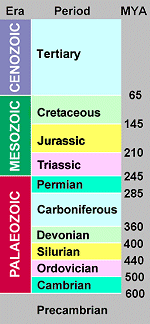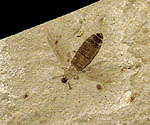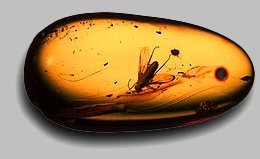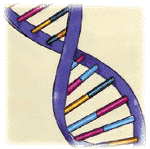Introduction to Systematics
 By human standards, 600 million years is a long, long time. Our human species is less than 2 million years old, birds and mammals have existed for no more than 200 million years, dinosaurs first appeared 230 million years ago, and the most primitive land plants arose about 425 million years ago. But in order to observe the first arthropods, (phylum Arthropoda) we would have to travel back even further in time — to a point nearly 600 million years ago (the Cambrian period of the Paleozoic era) when bacteria and marine algae were the dominant forms of plant life, small invertebrate animals were abundant in warm, shallow seas, and land masses were still largely devoid of life.
By human standards, 600 million years is a long, long time. Our human species is less than 2 million years old, birds and mammals have existed for no more than 200 million years, dinosaurs first appeared 230 million years ago, and the most primitive land plants arose about 425 million years ago. But in order to observe the first arthropods, (phylum Arthropoda) we would have to travel back even further in time — to a point nearly 600 million years ago (the Cambrian period of the Paleozoic era) when bacteria and marine algae were the dominant forms of plant life, small invertebrate animals were abundant in warm, shallow seas, and land masses were still largely devoid of life.
 It seems incredible that we can even think of studying events that happened so long ago. But biologists and paleontologists have a wide array of tools and techniques that allow them to probe the world of today for clues that illuminate events of our distant past. Such clues form an ever-growing patchwork of data that has begun to merge into a rough outline of the arthropods’ phylogenetic tree. Although most of our hypotheses about evolutionary beginnings are tentative and controversial, they provide a valuable framework in which to study similarities, differences, and relationships among all surviving taxa. Our understanding of each phylogenetic group is enhanced by learning how it has been shaped by the selective pressures of the past, and how it differs from its nearest relatives of the present.
It seems incredible that we can even think of studying events that happened so long ago. But biologists and paleontologists have a wide array of tools and techniques that allow them to probe the world of today for clues that illuminate events of our distant past. Such clues form an ever-growing patchwork of data that has begun to merge into a rough outline of the arthropods’ phylogenetic tree. Although most of our hypotheses about evolutionary beginnings are tentative and controversial, they provide a valuable framework in which to study similarities, differences, and relationships among all surviving taxa. Our understanding of each phylogenetic group is enhanced by learning how it has been shaped by the selective pressures of the past, and how it differs from its nearest relatives of the present.
Tools and Techniques
The science of paleontology (the study of prehistoric forms of life) and the principles of systematics (classification of organisms based on structural or evolutionary relationships) are the traditional foundations of phylogenetic research. Both endeavors are based on two important assumptions:
- All forms of life share a similar DNA-based system of inheritance, and
- The process of natural selection has remained virtually unchanged throughout evolutionary time.
Fossil Record
 The fossil record is the pre-eminent database for phylogenetic research. Prehistoric arthropods were generally small and delicate. They did not preserve as well as larger animals with teeth, bones, or shells, but are more abundant as fossils than other soft-bodied invertebrates because their rigid exoskeleton maintained its shape and did not decay rapidly after death. Fossil arthropods can be found in sedimentary rock strata and in deposits of coal, shale, or volcanic ash throughout the world. Good fossil beds containing arthropods are relatively scarce, so the fossil record tends to be patchy. Many species are known to science by only a single specimen, while others are recognizable as species that still live today.
The fossil record is the pre-eminent database for phylogenetic research. Prehistoric arthropods were generally small and delicate. They did not preserve as well as larger animals with teeth, bones, or shells, but are more abundant as fossils than other soft-bodied invertebrates because their rigid exoskeleton maintained its shape and did not decay rapidly after death. Fossil arthropods can be found in sedimentary rock strata and in deposits of coal, shale, or volcanic ash throughout the world. Good fossil beds containing arthropods are relatively scarce, so the fossil record tends to be patchy. Many species are known to science by only a single specimen, while others are recognizable as species that still live today.
 Fossil insects can also be found in amber, the petrified resin (sap) of prehistoric trees. Once entangled in the sticky resin, captive insects were preserved in every detail as the viscous sap gradually hardened to glass-like consistency. Amber deposits, containing embedded insects from the early Cretaceous period through recent times, can be found in northern Europe (around the shores of the Baltic Sea), in Asia (e.g. Burma and Siberia), and in North America (Canada, Alaska, Mexico, and the Dominican Republic).
Fossil insects can also be found in amber, the petrified resin (sap) of prehistoric trees. Once entangled in the sticky resin, captive insects were preserved in every detail as the viscous sap gradually hardened to glass-like consistency. Amber deposits, containing embedded insects from the early Cretaceous period through recent times, can be found in northern Europe (around the shores of the Baltic Sea), in Asia (e.g. Burma and Siberia), and in North America (Canada, Alaska, Mexico, and the Dominican Republic).
Until recently, scientists were forced to rely almost exclusively upon their own interpretations of the fossil record to reconstruct phylogenetic relationships. Many structural similarities between organisms are regarded as evidence of homology (kinship), while many dissimilarities signify unrelatedness. Problems often arise because of differences in interpretation, absence of intermediate forms, loss of specialized adaptations (reversion to more primitive conditions), and development of similar characteristics in unrelated groups (convergent evolution). Classical taxonomists have always been constrained by the overwhelming volume of data and the subjectivity of the process.
Within the past thirty years, however, exciting developments in chemistry, physics, and computer science have given evolutionary biologists a number of powerful new tools that furnish more precise and objective information about fossils and their relationship to extant life-forms.
Radiometric dating
 The approximate age of a fossil is vital information in assessing where it might fit into the family tree of its relatives. Fossils traditionally have been dated by the rock strata in which they occur. Relatively accurate ages of these strata can be inferred by measuring the concentration of a radioactive isotope (such as carbon-14) or by determining the ratio between a radioactive element (uranium-235, thorium-232, or potassium-40) and its spontaneous decay product. Plants and animals assimilate carbon-14 from the atmosphere only while they are alive, so it is possible to determine approximate age of a fossil by measuring how much carbon-14 has not yet decayed to nitrogen-14. Carbon dating is reliable only on specimens young enough to retain measurable amounts of carbon-14 (less than 50,000 years old).
The approximate age of a fossil is vital information in assessing where it might fit into the family tree of its relatives. Fossils traditionally have been dated by the rock strata in which they occur. Relatively accurate ages of these strata can be inferred by measuring the concentration of a radioactive isotope (such as carbon-14) or by determining the ratio between a radioactive element (uranium-235, thorium-232, or potassium-40) and its spontaneous decay product. Plants and animals assimilate carbon-14 from the atmosphere only while they are alive, so it is possible to determine approximate age of a fossil by measuring how much carbon-14 has not yet decayed to nitrogen-14. Carbon dating is reliable only on specimens young enough to retain measurable amounts of carbon-14 (less than 50,000 years old).
Older strata of rock that bear trace amounts of radioactivity may be dated by measuring the ratio between an unstable isotope (such as uranium-235, thorium-232, or potassium-40) and its stable decay product (lead-207, lead-208, or argon-40 respectively). The very long half-life of these isotopes (from 713 million to 14 billion years), makes them potentially useful for dating samples that range in age from 100,000 years to well before the beginning of prehistoric life.
Numerical Taxonomy
Digital computer technology provides a new and highly objective approach to evaluating similarities and differences among taxa. Statistical techniques, such as principal components analysis, cluster analysis, factor analysis, multidimensional scaling, and discriminant analysis can be applied methodically to large data sets containing morphological, behavioral, or biochemical information about taxonomic groups of interest. These statistical methods allow taxonomists to quantify the degree of overall similarity among groups of organisms. More about
Phylogenetic Trees The calculations may employ both “primitive” and “advanced” character states (the phenetic approach) or rely exclusively on “advanced” characteristics (the cladistic approach). In either case, the resulting “phylogenetic trees”, variously known as phenograms, cladograms, or dendrograms, are intended as visual representations of perceived biological affinity. They may (or may not) depict true evolutionary relationships.
Biochemistry
Enzymes and metabolic pathways can reveal inherent patterns in nutrient processing, chemical defense, locomotion, intercellular and intracellular communication, or homeostatic mechanisms. Similarities and/or differences in these basic life processes are often consistent within an evolutionary lineage. The sudden appearance of a novel biochemical mutation may confer selective advantages and eventually lead to adaptive radiation of new species from a common ancestor.
Nucleotide Sequencing
 Automated methods of sequencing nucleotides in DNA (and ribosomal RNA) have opened a new window to the past. We are discovering that the evolutionary “distance” between two organisms can be inferred from the number and frequency of changes in the sequence of base-pairs in corresponding regions of DNA (or RNA). By assuming that mutation rates have been relatively constant throughout geological history, it is possible to estimate how long it has been since any two groups diverged from a common ancestor. Recently, biologists have even extracted and sequenced DNA from fossils. This amazing feat was accomplished by isolating fragments of DNA from insects (termites and stingless bees) preserved in amber. The fossil DNA was cloned (replicated) using polymerase chain reaction (PCR), an enzymatic method that mass-produces identical copies of a DNA molecule. When enough of the prehistoric DNA had been manufactured, it was sequenced and compared to similar fragments from the insects’ living relatives. If these techniques prove applicable to a broad range of preserved specimens, they will allow us to study the genetic makeup of extinct organisms, and revolutionize our ability to explore relationships among the arthropods of today and their long-extinct ancestors.
Automated methods of sequencing nucleotides in DNA (and ribosomal RNA) have opened a new window to the past. We are discovering that the evolutionary “distance” between two organisms can be inferred from the number and frequency of changes in the sequence of base-pairs in corresponding regions of DNA (or RNA). By assuming that mutation rates have been relatively constant throughout geological history, it is possible to estimate how long it has been since any two groups diverged from a common ancestor. Recently, biologists have even extracted and sequenced DNA from fossils. This amazing feat was accomplished by isolating fragments of DNA from insects (termites and stingless bees) preserved in amber. The fossil DNA was cloned (replicated) using polymerase chain reaction (PCR), an enzymatic method that mass-produces identical copies of a DNA molecule. When enough of the prehistoric DNA had been manufactured, it was sequenced and compared to similar fragments from the insects’ living relatives. If these techniques prove applicable to a broad range of preserved specimens, they will allow us to study the genetic makeup of extinct organisms, and revolutionize our ability to explore relationships among the arthropods of today and their long-extinct ancestors.

